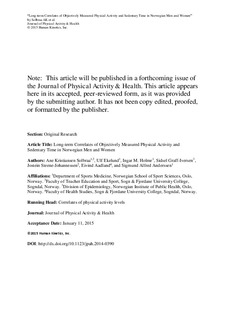| dc.contributor.author | Solbraa, Ane | |
| dc.contributor.author | Ekelund, Ulf | |
| dc.contributor.author | Holme, Ingar Morten K. | |
| dc.contributor.author | Graff-Iversen, Sidsel | |
| dc.contributor.author | Steene-Johannessen, Jostein | |
| dc.contributor.author | Aadland, Eivind | |
| dc.contributor.author | Anderssen, Sigmund A. | |
| dc.date.accessioned | 2016-11-18T08:18:01Z | |
| dc.date.available | 2016-11-18T08:18:01Z | |
| dc.date.issued | 2015 | |
| dc.identifier.citation | Journal of Physical Activity and Health. 2015, 12, 1500-1507 | nb_NO |
| dc.identifier.issn | 1543-3080 | |
| dc.identifier.uri | http://hdl.handle.net/11250/2421721 | |
| dc.description | Dette er siste tekst-versjon av artikkelen, og den kan inneholde små forskjeller fra forlagets pdf-versjon. Forlagets pdf-versjon her: www.humankinetics.com: http://dx.doi.org/10.1123/jpah.2014-0390 / This is the final text version of the article, and it may contain minor differences from the journal's pdf version. The original publication is available at www.humankinetics.com: http://dx.doi.org/10.1123/jpah.2014-0390 | nb_NO |
| dc.description.abstract | Background: Sex, age, body mass index (BMI), perceived health and health behavior are correlates known to affect physical activity and sedentary time. However, studies have often been cross-sectional, and less is known about long-term correlates. Thus, the aims were to investigate 1) the associations between a set of characteristics (demographic, biological, psychological and behavioral) and objectively measured physical activity and sedentary time at 13 year follow-up, and 2) the association between changes in these characteristics over time and physical activity and sedentary time. Methods: Baseline characteristics were collected in 40-year-olds in 1996, and follow-up data on objectively measured physical activity and sedentary time were obtained in 2009 (n=240). Data were analyzed by multiple linear regressions. Results: Self-reported physical activity (p<0.001) and improved perceived health (p=0.046) were positively associated with moderate-to-vigorous physical activity (MVPA) whereas BMI (p=0.034) and increased BMI (p=0.014) were negatively associated with MVPA at follow-up. Women spent less time being sedentary than men (p=0.019). Education (p<0.001) was positively associated and improved perceived health (p=0.010) was negatively associated with sedentary time at follow-up. Conclusions: MVPA and sedentary time at follow-up were associated with behavioral, biological and demographic correlates. However, the nature of our analyses prevents us from inferring causality. | nb_NO |
| dc.language.iso | eng | nb_NO |
| dc.publisher | Human Kinetics | nb_NO |
| dc.subject | accelerometry | nb_NO |
| dc.subject | health behavior | nb_NO |
| dc.subject | health | nb_NO |
| dc.title | Long-term correlates of objectively measured physical activity and sedentary time in norwegian men and women | nb_NO |
| dc.type | Journal article | nb_NO |
| dc.type | Peer reviewed | nb_NO |
| dc.source.pagenumber | 1500-1507 | nb_NO |
| dc.source.volume | 12 | |
| dc.source.journal | Journal of Physical Activity and Health | nb_NO |
| dc.source.issue | 11 | nb_NO |
| dc.identifier.doi | 10.1123/jpah.2014-0390 | |
